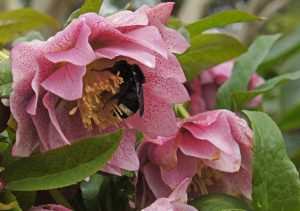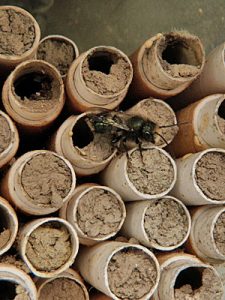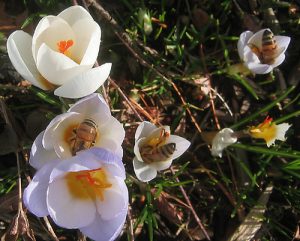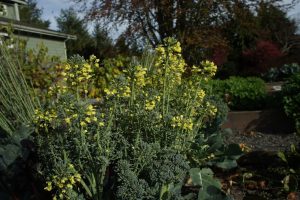
Bumblebee in Hellebore
Download a pdf on Encouraging Pollinators
Most people have heard the news that honeybees are in trouble in this country. If you’ve planted fruit trees in your garden, you have even more to worry about- who is going to pollinate those flowers so you get the bounty of fruit you were anticipating? What can you do to encourage pollinators, including honeybees, to visit your orchard?
The first and most important thing you can do is to be very careful with pesticides when pollinators are active. Even organic pesticides can be toxic to bees and other pollinators, so if you must spray, spray when they are not foraging (early morning or late evening).

Blue Orchard or Mason bee
To attract some of the native pollinators to your orchard, providing suitable nesting sites or shelter is effective. The Mason bee or Blue Orchard bee, Osmia lignaria, is the most well-known of these native pollinators. This solitary bee nests in holes plugged by mud. Bundles of straws, drilled blocks of wood, or bundles of hollow reeds can all provide suitable nest holes for these pollinators. The tubes or holes should be 5/16″-3/8″ in diameter and at least 5″ deep. Blocks or straw boxes should be mounted on south or east facing areas out of rainfall. These small bluish black bees are most active late March through mid-April and are especially good pollinators for early blooming fruit like plums and cherries. For more information about building nest blocks for mason bees, check out the Xereces Society nest construction info sheet.
Other pollinators include the numerous species of bumblebees, Bombus sp., native to our area (more than 30 species!) These colony nesting bees are active from February through late fall, so providing pollen and nectar sources as well as nesting sites can help encourage them. They nest in abandoned mouse nests or clumps of old grass. You can also buy bumblebee nest boxes, or build them from readily available plans. These furry pollinators are especially effective for blueberries and tomatoes. An advantage of both mason bees and bumblebees is that they rarely sting (although they are capable). The Pacific Northwest has many native bees, and it can be a fascinating topic to explore.
Another easy way to encourage pollinators is to add plants to your orchard or surrounding garden that are attractive to them. You’ve already planted fruit trees. So while the trees are in bloom, April to early May, you have provided a nectar and pollen source for the pollinators. What you do NOT want to do is to plant more sources that bloom at exactly the same time as your fruit trees! One note to remember when planting pollinator attracting plants, is that while native bees and other pollinators will visit a variety of plants on the same trip, honeybees tend to visit one type of plant per trip.
Plan for a full year’s bloom to support local pollinators over the long term. This will especially help wild hives of honeybees, which do not go dormant in winter. Bees do rely on ‘wild’ areas and many weedy species as well as those we plant. A diverse selection of perennial and woody plants, along with annuals in the summer, can help not just the honeybees, but other pollinators and beneficial insects.
The lists below are some commonly available plants that we’ve observed pollinators using at different times of year. Searching the web will give you a wealth of information for your area. For those in Western Washington and Oregon, we can recommend Selecting Plants for Pollinators. Another good resource is the USDA Agroforestry publication on enhancing pollinator habitat.
December-February
This is a time of year when little is blooming. Planting some of the following plants can help pollinators make it through the winter.
| Plant botanical name | Common name | Shrub/Tree, Perennial, Annual | Native? |
| Viburnum b. ‘Dawn’, Viburnum farreri | Fragrant Winter Viburnum | Shrub | No |
| Corylus sp. | Hazelnut | Tree | Some |
| Mahonia intermedia | Hybrid Mahonia | Shrub | No |
| Helleborus niger, hybridus | Hellebore, Lenten Rose | Perennial | No |
| Alnus rubra | Red Alder | Tree | Yes |
| Salix sp. | Pussy Willow | Shrub/Tree | Some |
| Arctostaphylos sp. | Manzanita | Shrub | Yes |
| Erica x darlyensis | Winter Heather | Low shrub | No |
| Crocus species & hybrids | Crocus | Perennial bulb | No |

Honeybees in crocus mid-February
March-May
This includes the period that your fruit trees will be blooming; try to plant more of plants that do not bloom with your trees, but before and after.
| Plant botanical name | Common name | Shrub/Tree, Perennial, Annual | Native? |
| Ribes sanguinium | Red Flowering Currant | Shrub | Yes |
| Acer species | Maples | Tree | Some |
| Mahonia aquifolium | Oregon Grape | Shrub | Yes |
| Populus species | Cottonwood, Aspen | Tree | Yes |
| Sambucus racemosa | Red Elderberry | Shrub | Yes |
| Taraxacum officianale | Dandelion | Perennial | No |
| Salvia rosemarinus (Rosemarinus officianalus) | Rosemary | Shrub | No |
| Vaccinium species | Blueberry, Huckleberry, cranberry | Shrub | Some |
| Amelanchier species | Serviceberry | Shrub | Some |
| Rubus species | Blackberry, Raspberry | Shrub | Some |
May-August
This is when your plantings are most important to pollinators other than honeybees: bumblebees, syrphid flies, some solitary bees.
| Plant botanical name | Common name | Shrub/Tree, Perennial, Annual | Native? |
| Arbutus menzesii | Madrone | Tree | Yes |
| Brassica family | Annuals such as kale, broccoli | Annual | No |
| Symphoricarpos albus | Snowberry | Shrub | Yes |
| Herbs | Lavender, Thyme, Oregano, Mint | Shrub, perennial | No |
| Agastache species | Hyssop | Perennial | No |
| Penstemon species | Penstemon, beardtongue | Perennial | Some |
| Salvia species | Sage | Perennial | No |
| Epilobium species | Fireweed, others | Annual | Some |
| Trifolium species | Clover | Perennial, annual | Some |
| Calluna vulgaris | Scotch Heath | Low shrub | No |
| Achiellia millifolium | Yarrow | perennial | Some |
| Borago officinalis | Borage | Annual | No |
| Lobularia maritima | Sweet Alyssum | Annual | No |
| Coriandrum satirum | Coriander, Cilantro | Annual | No |
| Cosmos binpinnatus | Cosmos | Annual | No |
| Phacelia tanaecitifolia | Bee’s Friend | Annual | No |

Broccoli blooming late fall
September-November
This is the time of year that many pollinators are still active, but not much is in bloom.
| Plant botanical name | Common name | Shrub/Tree, Perennial, Annual | Native? |
| Aster species | Aster | Perennial | Some |
| Solidago species | Goldenrod | Annual | Yes |
| Chrysanthemum hybrids | Chrysanthemum (single ) | Perennial | No |
| Heptacodium micanoides | Seven Son Tree | Large shrub | No |
| Helianthus species | Sunflower | Annual or perennial | No |
| Brassica family | Annuals such as kale, broccoli- leave some to bloom after harvest | Annual | No |
